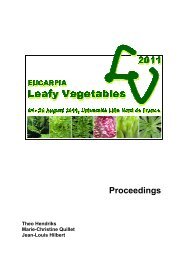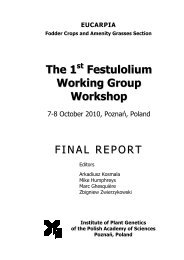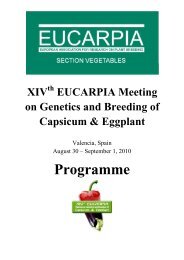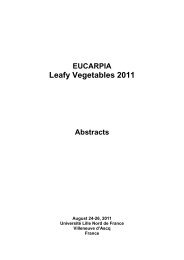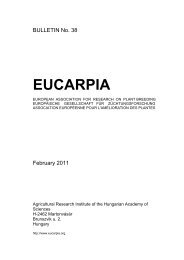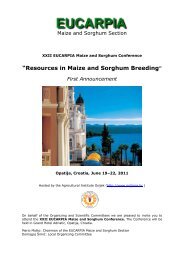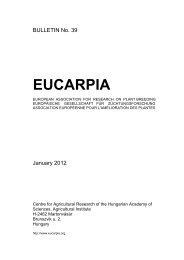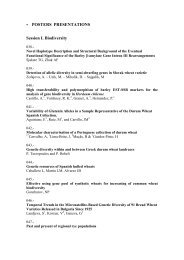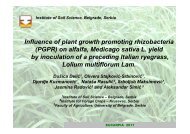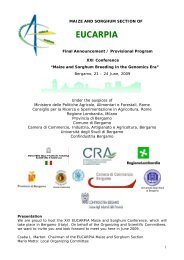Plant breeding for organic and sustainable, low-input agriculture
Plant breeding for organic and sustainable, low-input agriculture
Plant breeding for organic and sustainable, low-input agriculture
Create successful ePaper yourself
Turn your PDF publications into a flip-book with our unique Google optimized e-Paper software.
Cultivar x growing cycle interaction in lettuce grown under certified <strong>organic</strong> conditions:<br />
implications <strong>for</strong> selection, <strong>breeding</strong> <strong>and</strong> use of diversity<br />
María Dolores Raigón 1 , Jaime Prohens 2 , Fern<strong>and</strong>o Nuez 2<br />
1 Departamento de Química, Universidad Politécnica de Valencia, Spain<br />
2 Instituto de Conservación y Mejora de la Agrodiversidad Valenciana, Universidad Politécnica<br />
de Valencia, Spain<br />
The increased dem<strong>and</strong> of <strong>organic</strong>ally produced lettuce (Lactuca sativa) has led to the necessity to<br />
offer an extended period of supply of the produce. While this can be achieved by growing the<br />
crop in different regions or by the use of protected cultivation, the use of several growing cycles<br />
in a certain region, combined with appropriate varieties can contribute to extending the period of<br />
production, which is important if the combination of “<strong>organic</strong> + local” production is pursued.<br />
Given that the conditions in early <strong>and</strong> late cycles may be different from those of the common<br />
cycle, interactions cultivar x growing cycle may exist.<br />
Fifteen varieties of lettuce from six varietal groups (“Batavia”, “butterhead”, “lollo green”, “lollo<br />
red”, “oakleaf green”, <strong>and</strong> “oakleaf red”) were grown in three growing cycles (early,<br />
intermediate, <strong>and</strong> late) under <strong>organic</strong> cultivation conditions in a farm of the Committee of<br />
Organic Agriculture of the Valentian Community situated in Sagunto (Valencia, Spain). The<br />
transplants of the early, intermediate <strong>and</strong> late cycles were made in December, January <strong>and</strong><br />
February, respectively, using a completely r<strong>and</strong>omized design, with 3 replications <strong>and</strong> 32 plants<br />
per replication. Traits evaluated have been total <strong>and</strong> commercial yield, gross <strong>and</strong> net weight, size<br />
of the head, <strong>and</strong> resistance to bolting.<br />
Under the <strong>organic</strong> cultivation conditions tested, there are important effects of cultivation cycle,<br />
varietal group, cultivar within varietal group, as well as interactions between cultivation cycle<br />
<strong>and</strong> varietal group, <strong>and</strong> between cultivation cycle <strong>and</strong> cultivar within varietal group. In general,<br />
the best average results are obtained in the intermediate cycle, fol<strong>low</strong>ed by the late cycle, <strong>and</strong><br />
finally by the early cycle. Important differences were also found among the means <strong>for</strong> cultivar<br />
groups, with the highest yields obtained in the “oakleaf green” <strong>and</strong> “lollo green” cultivar groups,<br />
<strong>and</strong> the <strong>low</strong>est in the “lollo red” group. However, there were important interactions between<br />
cultivation cycle <strong>and</strong> varietal group. At this respect the highest yielding varietal type in the early<br />
<strong>and</strong> intermediate cycle has been the “oakleaf green”, while <strong>for</strong> the late cycle has been the<br />
“butterhead”. Differences in the per<strong>for</strong>mance <strong>and</strong> crossed interactions with the cultivation cycle<br />
have also been found within varietal type. Some differences were also observed in the resistance<br />
to early bolting. While no cultivar was prone to bolting in the early cycle, three of them (all of<br />
the “oakleaf” groups) showed symptoms of early bolting in the intermediate cycle, <strong>and</strong> three<br />
other (all of the “lollo” groups) in the late cycle. The results show that the important cultivar x<br />
growing cycle interaction that takes place in the cultivation of lettuce under <strong>organic</strong> conditions<br />
can be exploited by selecting the best cultivars <strong>for</strong> each growing cycle. The fact that the<br />
materials of lettuce with better per<strong>for</strong>mance in each growing cycle are different, even within the<br />
same cultivar group, supports the general view that the use of diversity can be used to a great<br />
advantage in the production of <strong>organic</strong>ally grown vegetables.<br />
20




